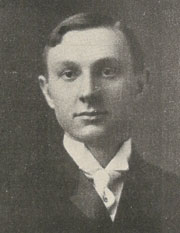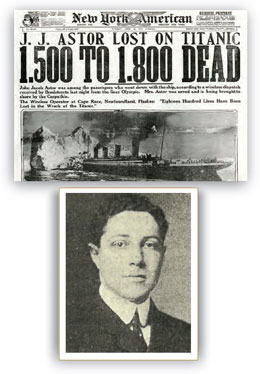Norman Chambers had been in bed at the time of the collision, noticing no great shock. The loudest noise, he later testified in front of a U.S. Senate subcommittee, came from "jangling chains whipping along the side of the ship." It passed quickly, and he assumed something had gone wrong with the engines on the starboard side. But Bertha insisted that he investigate, so he put on an overcoat and strolled up to the A deck. He noticed an unusual coldness in the air, but he was unable to see anything as he looked over the side. He returned to their stateroom.
Minutes later, he and Bertha noticed that the ship was significantly listing to starboard. Chambers made his way to the mail-sorting room, where he found a couple of clerks wet to their knees. They had just come up from below, bringing their registered mail bags. The door in the bulkhead on the next deck down was open, and Chambers could see directly into the trunk room. It was filled with water to within a couple of feet of the deck above.
Still, there was no sense of urgency. Chambers and his wife joked about their baggage being soaked. As they headed down an alleyway toward their stateroom, a steward came by and told them they could go back to bed. "In this I agreed with him, personally," Chambers later admitted. But Bertha lingered in the passageway and soon came rushing back, telling her husband that another passenger had informed her that the call had been given out for lifebelts. Chambers verified this with a room steward and packed the pockets of his overcoat with some necessities.
What possessions does one choose in such a situation? Titanic historians love such minutiae, believing it reveals much about the people involved. Adolf Dyker handed his wife a satchel containing two diamond rings, two gold watches, a sapphire necklace, and 200 Swedish crowns. Lawrence Beesley stuffed his jacket pockets with books. Stewart Collett carried his Bible. Edith Rosenbaum grabbed her musical toy pig. And Norman Chambers? A pocket compass and an automatic pistol, along with his flask and pipe.

As the couple moved upward through the ship, they passed people who, recalled Chambers, "did not appear to be particularly frightened." They made their way to the boat deck, arriving on the port side but then crossing over to starboard. "Owing to the list being to the starboard," Chambers explained, "I assumed that the boats which were lowered on the starboard side would be sure to clear the ship, while those on the port side might have some difficulty." While this was not the case, the notion likely saved his life. The crew loading lifeboats on the port side refused to allow men on board.
Norman Chambers had been in bed at the time of the collision. The loudest noise, he later testified, came from ‘jangling chains whipping along the side of the ship.'
Steam was pouring from a single pipe on the starboard side of the forward funnel, creating such a noise that it was possible to communicate on the boat deck only by shouting. Chambers gave his wife a drink from his flask, and they walked as far forward as possible until they reached the last forward starboard group of lifeboats.
By then, Gilbert Tucker was already sitting in lifeboat number seven, the first boat launched from the starboard side—less than half-filled to capacity. Tucker and the three women he was escorting had been told by a steward that, yes, they had hit an iceberg. But no worries; go back to bed. However, as Tucker started back to his cabin, he came across Captain Edward Smith ordering officers to prepare to lower the lifeboats. The ship was equipped with only enough lifeboats—twenty in all—to hold half of the passengers.
When Tucker and his companions arrived at the boat deck, they were told only that "the Captain wants to lighten the boat while repairs are being made." Margaret Hays (carrying her tiny Pomeranian, one of only three dogs saved) stepped into the boat along with her two traveling companions. Tucker later claimed that he hesitated, explaining, "When the boat was about fifteen feet below the rail, my friends called to me to come along, and with one or two other men I slid down the ropes." We'll be back on board for breakfast, he thought.
Meanwhile, lifeboat number five, the second starboard boat launched, was already swung out level with the deck when Bertha Chambers announced she was getting on. She climbed in, calling her husband to join her. "As I knew she would get out again had I not come, I finally jumped into the boat," he later testified, "although I did not consider it, from the looks of things, sage to put very many more people in that boat." Alas, the lifeboat was filled only to two-thirds capacity, its passengers reflecting the diversity of the ship's cargo. There was a couple from England, another from Switzerland, two East Asian stowaways, and the French maitre d' of Titanic's à la carte restaurant. Chambers was sitting next to a Davis Cup tennis player named Karl Behr; months later, the two men realized they'd attended prep school together. Their lifeboat launched at 12:55 a.m., some seventy-five minutes after Titanic struck the iceberg.
At almost the exact same time, the first lifeboat was being launched from the port side—where no men were being allowed to board unless they were assigned crewmen. Edgar and Leila Meyer stood there, debating. He tried to convince her to climb into the lifeboat. She refused. "I tried and tried to get Edgar to come into the lifeboat with me and pleaded to be allowed to stay behind and wait until he could leave," she later explained. But after Edgar reminded her of their one-year-old daughter back home, Leila climbed into lifeboat number six—the boat featured in James Cameron's 1997 film, the one that the heroine was supposed to board before she ran back to find her beloved.
The ship's stern rose high in the air. The boilers exploded. The boat begin to splinter into two halves. And then the survivors in the lifeboats heard the anguished cries of hundreds.

The boat launched with only twenty-three people on board, despite a capacity of sixty-five. Among the passengers were the lookout who had first spotted the fateful iceberg and quartermaster Robert Hichens, who had been manning the wheel at the moment of impact. As the lifeboat floated among cakes of ice, Hichens clashed repeatedly with another passenger, the "unsinkable" Molly Brown, about moving toward the ship to pick up survivors. Brown eventually prevailed, but too late. "Only a short time did I see my husband standing beside the rail and assisting other women into boats in which he might have been saved," Leila Meyer recalled. Then she just sat there and "watched as the Titanic sank."
For a time, the ship looked almost serene in the night, illuminated from stem to stern. But then the lights began to flicker and disappear. "I kept my eyes on the liner and could see six rows of portholes," recalled Lily Potter, one of three women escorted by Gilbert Tucker in lifeboat number seven. "I looked again and there were five rows, then only four, and then I knew she was going down." The ship's stern rose high in the air. The boilers exploded. The boat began to splinter into two halves. And then the survivors in the lifeboats, barely a half-mile away, heard the anguished cries of hundreds—clinging to the ship and then, when it disappeared, flailing in the frigid Atlantic. "The horror of those sights, those sounds," Gilbert Tucker reflected, "is something never to be forgotten." And then slowly, terrifyingly, the cries ceased. Only the sound of the sea remained.


